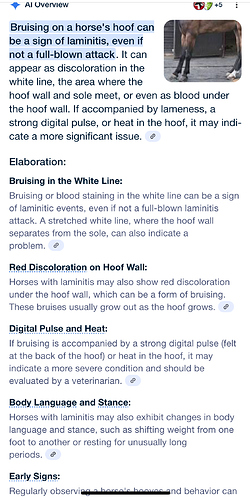The saga of trying to get husband’s horse back to 100% continues…
I know sometimes steroids can cause laminitis, but anyone experience other hoof issues following injections?
We had hocks injected in early March. After the rest period, he didn’t appear much better. First day back under saddle, he felt tight in LH. Next day husband found a small, sharp rock that was embedded in the LH frog. There was a little blood when he pulled it out so we assumed that was the issue.
When farrier came 5 weeks post injection, he found bruising on all 4 feet around frog and toes and heel of LH + a small abscess on RH. The appointment before this his feet were perfect. He had primarily been on indoor turnout and only ridden lightly a couple times so the bruising seemed odd.
When he was injected 6 months prior, 3 weeks after the farrier found some separation at the toe and the voids were full of “black gunk” and bruising in the medial toe and abscess in the lateral toe, extending thru the lateral quarter.
Kenalog was used both times and farrier seems to think the feet issues are related, but I haven’t been able to find much info on a correlation. Other vets we’ve worked with seem to favor using betavet but current vet prefers kenalog for certain uses.
During this time horse has been on doxy for Lyme and we recently switched to minocycline. We also started gastroguard a week ago b/c we suspected ulcers (based on vet checking acupuncture points and other behavioral observations).
The week after shoeing and a few days after starting the new meds, he was looking really good on lunge line. But then over the last few days is starting to look stiff and uncomfortable again though not lame per se.
Vet is returning this week and we are considering whether his RF coffin needs to be reinjected as we also did that 6 months ago but not with the latest hock injections. But I’m debating whether I should ask him to use a different drug.
Really at a loss as to what this guy needs…over the last year we’ve done
RF coffin - Renovo, injections + Noltrex
RH - lower hock injections + Noltrex | upper and lower injections
LH - lower hock injections | upper and lower injections
Round of Zycosan in Dec
Daily firocoxib
Farrier also suggested trying Polyglycan but I didn’t want to throw another med into the mix until we see how he does w/ the GG and mino.

